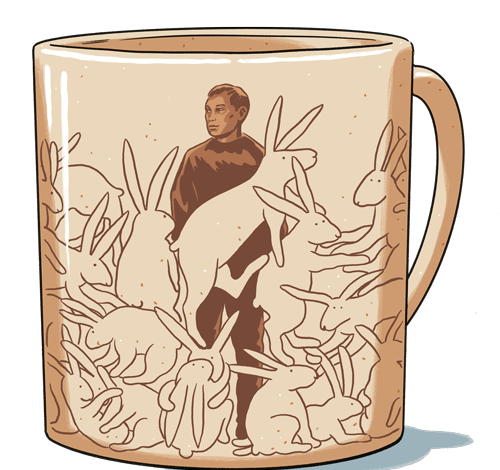
Excerpts from The Believer: Finding Win Ng
In the 1960s, a Chinese American ceramicist built one of the first widely known lifestyle brands. Why, despite the iconic status of his work, is so little known about the artist himself?
Ten years ago in Nevada City, California, I encountered two coffee mugs in the front seat of an old Mercedes station wagon belonging to Joe Meade, an artist and collector. They immediately caught my eye: oversize and made of white porcelain, they were wrapped in charming illustrations, quirky line drawings depicting a mass of rabbits tumbling in playful, erotic entanglements. “Those are cool,” I said. “What are they?” “Woah, dude, you haven’t heard of Taylor and Ng?” Joe was delighted. “You’re gonna love this. It’s very Bay Area.”
I held the cartoon-animal-orgy mugs in my lap as we drove to Grass Valley, and Joe, with his encyclopedic knowledge of California ceramics, gave me a crash course on their cultural significance and the life of their maker, the late artist Win Ng. Created for the home-goods company that Win cofounded in 1960, the mugs were subtly provocative mementos of mid-century San Francisco, evoking the sexual revolution and the gay civil rights movement. Though they joyfully depicted free love, they were sold in high-end department stores and made their way into the homes of everyday people—not just those inclined toward countercultural and queer lifestyles. In addition to running his company, Joe said, Win Ng was an exceptionally talented abstract sculptor working at a pivotal moment in California ceramics, a time when the medium was expanding beyond its siloed place as craft and into the world of fine art.
At the time of my ride-along with Joe, I was feeling like an outlier in my master’s of fine arts graduate program in San Francisco. While my peers were casually discussing theory at the bar, striving for commercial gallery representation, and immersing themselves in the Art World (capital A, capital W), I was emphatically not. Instead, I was a graphic designer and journalism school dropout, interested in the vernacular and in hyperlocal narratives of place, especially within San Francisco, where I was born and raised. Win’s story—of someone who straddled the dualities of art and design, of commerce and concept—felt like a gift, like a taste of something I was hungry for. Despite the art history classes I’d taken, and despite my attraction to homegrown Bay Area art scenes, here was a San Francisco artist I’d never heard of.
As the years went by, I continued to encounter Win’s work in improbable yet familiar places. I found him on my mom’s bookshelf, in a 1971 book called Herbcraft, published by Yerba Buena Press, an imprint of his company. Inside, on the textured, cream-colored pages, were folksy, near-psychedelic drawings of nude waifs sitting on toadstools beside enormous sprigs of mint. I found Win in my grandmother’s dank cabin in the redwoods, when I noticed, after decades of visiting, that the doorstop holding open the bunkroom door was a Taylor & Ng bacon press, a grinning cartoon pig cast in iron. There he was, peeking out of my aunt’s bin of cleaning rags: a Taylor & Ng Christmas dish towel from 1983, soft and stained, featuring an ice-skating rat wearing a Santa hat. My chance meetings with these objects in my everyday life stoked the deepest sense of intrigue. To me, they represented an undercurrent of Bay Area material culture, mementos of another time, place, and energy. I was determined to learn more, so I began my process of inquiry in a place I know well: the internet.
Win Ng was born and raised in Chinatown, one of eight children. Starting in the mid-1950s, he contributed to an important movement in ceramics, as part of a loose group of West Coast artists that included Peter Voulkos and Robert Arneson, whose nonfunctional, abstract work helped shift the medium from a utilitarian, traditional craft toward a sculptural fine art rooted in expression. In 1960, just as his fine-art career was taking off—with solo shows and critical reviews—Win and his then boyfriend, artist Spaulding Taylor, began to make and sell their functional work together. Their collaboration eventually became Taylor & Ng, an early lifestyle brand that achieved mainstream commercial success. His multidisciplinary practice spanned ceramics, illustration, painting, industrial design, and creative merchandising. A critic referred to him in 1960 as “a veritable dynamo of creative energy.” In 1963, Win told Ceramics Monthly, “I don’t think of art—I just do it. It’s part of living.”
I dug into online newspaper archives, saving every scrap I could find to my desktop. And still, with each new fact I found, a thousand more questions unfurled before me. And what else? I wondered. Who was Win Ng? What could his life tell me about San Francisco? About my own creative practice? I quickly ran into the edges of the internet’s information on Win. His Wikipedia page is anemic, and the few online artist profiles recycle the same information. He is largely absent from the art-historical record, despite his achievements and popularity. I had found a San Francisco artist’s story that I couldn’t easily read elsewhere, a shiny, magnetic bit of intrigue—a story that I’d have to assemble for myself.
When Win’s work found me, over and over again, it spoke to me loud and clear, its personality bursting with humor and warmth. I sensed that his work and story deserved to be known. And so I called strangers, scrolled eBay, and circled the Bay Area to find the objects he made, the places he lived and worked, and the people he knew and loved. I wanted to piece together Win’s story, so that others might know him too.
Read the rest of this article over at The Believer.